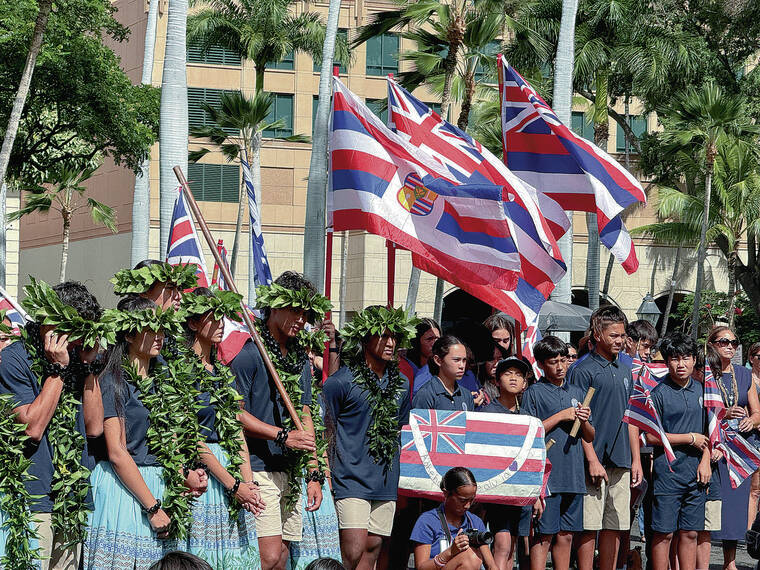Copyright staradvertiser

Under a mix of hot sun and passing rain, hundreds of students, alumni, lawmakers and community members gathered Tuesday morning on the grounds of Iolani Palace — a site steeped in Hawaiian history — to show solidarity with Kamehameha Schools and its long-standing admissions policy favoring Native Hawaiian students. Most in the crowd wore blue, the color associated with the schools’ founder, Princess Bernice Pauahi Bishop. They carried Hawaiian flags, along with banners and posters decorated with messages such as “Ku i ka pono” and “Ola Pauahi, Ola Hawai‘i,” forming a sea of support less than 24 hours after the school called for the rally. The event came on the heels of a new lawsuit filed Monday by Students for Fair Admissions — the same nonprofit that successfully challenged affirmative action in U.S. college admissions before the Supreme Court two years ago. The complaint, filed in the U.S. District Court for the District of Hawaii, argues that Kamehameha Schools’ admissions policy violates federal civil rights law by giving preference to Native Hawaiians. Led by conservative activist Edward Blum, SFFA alleges that the schools’ policy breaches a Reconstruction-era law guaranteeing all people the same right to make and enforce contracts regardless of race. The case could reopen a decades-old legal debate over whether a private educational trust established to serve a native population can constitutionally maintain ancestry-based preferences. At Tuesday’s rally, organized overnight by Kamehameha Schools, the atmosphere was part protest, part prayer, part homecoming. Eighteen-year-old Kauakukalahale Lopez, a 2024 Kamehameha Schools Kapalama graduate now attending Chaminade University, said the speed and size of the turnout underscored the community’s shared sense of purpose. “Just to see how quickly everyone can come in less than a day shows the importance of what this event means and how important it is for Native Hawaiians,” Lopez said. “Everyone here is showing aloha. Pauahi is over here watching everyone.” Lopez attended the rally with his mother, 1997 graduate Tevairangi Lopez, offering an oli and ho‘okupu — placing a lei on Pauahi’s portrait. “Kamehameha Schools has done so much for me. It has changed my perspective as a Native Hawaiian,” Lopez said, adding that his education through Kamehameha Schools changed the course of his entire life. “Honestly, it is very tiring and very upsetting to see our culture and education constantly being threatened … but as long as we continue to persevere, which is what we’ve been doing for the longest time, then we can continue. “If it weren’t for Kamehameha Schools, I wouldn’t appreciate my culture and heritage and ancestry as much as I do now.” Puahai established the Kamehameha Schools in her 1883 will, entrusting her estate “to erect and maintain in the Hawaiian Islands two schools” for the education of children of Hawaiian blood. Today,Kamehameha Schools — Hawaii’s largest private landowner — funds a network of K-12 campuses and preschools serving thousands of students, as well as college scholarships, teacher training and community education programs that reach thousands more. The trust’s mission statement explicitly prioritizes improving the capability and well-being of Native Hawaiians through education — a focus that defenders say fulfills Pauahi’s will and addresses historic inequities that persist today. Native Hawaiians continue to face the lowest income, education and health outcomes among major ethnic groups in Hawaii. Kamehameha Schools’ admissions preference helps address these historic and ongoing disparities. Lopez said the lawsuit misrepresents the policy’s intent, noting that the school cannot accommodate all Native Hawaiian applicants and that labeling the preference as discriminatory ignores its role in leveling the educational playing field. “There’s not even enough seats for all Native Hawaiians who apply,” Lopez said. “The playing field isn’t even level — but the schools help make it fairer.” At the palace, student speakers shared reflections on Pauahi’s vision and the responsibility of the next generation to protect it. La‘iku Wong, a senior at Kamehameha Schools Kapalama, told the crowd she had been asked to speak about what she would say to Pauahi if she were there. “I would cry,” Wong said. “I would cry at the success of Hawaii today. Our people were decimated in poverty. Our people were decimated in education. And in disease. And we have come so far. Pauahi has brought lightness to the dark. Pauahi has brought education to our people of Hawaii. And she has brought a will to live by.” Another senior, Avapui Ulufale, said he felt called to defend the mission of his school. “We deserve … to educate all of our keiki o ka ‘aina, to continue to malama our role and kuleana as Kanaka Hawai‘i. … I stand here, alongside all of you … to continue to protect our will as a living embodiment of Kamehameha, and of Ke Ali‘i Pauahi.” For Kamehameha Schools, this is not the first time its admissions policy has faced a legal challenge. Two decades ago, non--Hawaiian students brought the Doe v. Kamehameha Schools cases, arguing that the school’s preference for Native Hawaiian applicants violated federal law. The 9th U.S. Circuit Court of Appeals upheld the policy, finding it served a legitimate remedial purpose. Now, the legal landscape has shifted. The 2023 Supreme Court decisions banning race-conscious college admissions, combined with changes in the 9th Circuit’s judicial makeup, make outcomes less predictable than in the early 2000s. Kamehameha Schools Board of Trustees Chair Crystal Rose, who served as outside counsel during the Doe litigation, expressed confidence. “We understand the law. We understand the facts. And the law and the facts are on our side,” she said. “With this kahua, we are confident and eager to protect Pauahi and move beyond this legal challenge.” She added that the trust’s focus remains on its educational mission. “Our mission continues, no matter the threats. We are warriors. We are fighters,” Rose said. One of the most meaningful moments of my career was defending our admissions policy two decades ago. And now as a trustee, I am more committed than ever to continue this work.” Moses Haia, a former Kamehameha Schools student and former executive director of the Native Hawaiian Legal Corp., explained that the policy is rooted in the rights of private trusts. He noted that the trust has the authority to direct its funds as it sees fit, and that the admissions preference was created to address historic injustices and the suppression of Native Hawaiian culture. Haia emphasized that Kamehameha Schools’ approach seeks to correct long-standing harms and preserve a cultural legacy that was once systematically outlawed. He also said the main difference between the Doe case and the current lawsuit is the courts themselves, which now include more conservative judges. Combined with the national shift against race-conscious admissions, the outcome could be less certain than it was in the early 2000s. Office of Hawaiian Affairs Trustee and Kamehameha Schools graduate Brickwood Galuteria said in a statement that the schools’ admission preference for children of Hawaiian ancestry is “not only morally justified but legally sound.” He noted that Kamehameha Schools is a private charitable trust whose resources come from the will of Princess Pauahi, and its admissions policy fulfills that fiduciary mandate. “To dismantle it would violate her express intent and the principles of trust law itself,” he wrote. “This is not ‘affirmative action.’ It is an act of Indigenous equity — rooted in Hawai‘i’s unique constitutional and legal recognition of Native Hawaiians as the Indigenous people of this land.” In an email to the Honolulu Star-Advertiser, Edward Blum said SFFA had received “a handful” of inquiries from Hawaii parents “over the last 2–3 years … especially after the SFFA v. Harvard case was decided.” The complaint itself references only two families, whose names are being kept confidential to protect their privacy. The filing also includes about 10 pages of threatening messages he has received since announcing the case — which was the key reason the families’ identities are not being publicly disclosed. The two families are listed as members of Students for Fair Admissions, rather than formal plaintiffs. Court documents describe one family as having a homeschooled white daughter in 10th grade, whose parents decided against applying to Kamehameha Schools due to concerns about “humiliation.” The second family has a second-grade daughter who is half-white and half-Asian, lives near the Kapalama campus, and has shown interest in the school’s programs, especially in the arts. That family similarly did not apply for fear of “humiliation,” despite being deeply committed to Native Hawaiian culture, the filing alleged. He defended the new lawsuit as part of a broader push for what he calls “race-neutral” admissions standards. He said his model “can take into account children from lower economic families,” but not race. “The local law firm representing SFFA has deep roots in Hawaii and understands the history and culture of the Hawaiian people,” Blum wrote. “I would like to stress to the leaders of Kamehameha School that it is fundamentally wrong to exclude children from attending any school because they are the wrong race. A nation can not remedy past discrimination with new discrimination.” State Rep. Darius Kila (D, Nanakuli-Maili) countered that labeling Kamehameha Schools’ admissions policy as discriminatory ignores the historical and ongoing disadvantages faced by Native Hawaiians. He noted that Native Hawaiians are the most affected group in Hawaii, with protections enshrined in the state Constitution and taught in public schools, and that the school’s mission to prioritize Native Hawaiian students does not violate Pauahi’s will. Blum did not respond when asked whether he or anyone from SFFA has visited Hawaii, toured Kamehameha Schools, or met with alumni or officials to better understand the school’s history. He asserted, however, that SFFA has “done extensive research on the school’s history, mission and curriculum, which we find admirable,” but maintained that the school’s admissions policy is discriminatory. Kila, who benefited from Kamehameha-funded scholarships, said the lawsuit misrepresents Pauahi’s intent and ignores the social context that made the trust necessary. “When you do your research off of things that fit your narrative, it’s dangerous,” Kila said. “If Native Hawaiian children are no longer prioritized for entry, what mechanisms would ensure that those most affected by colonization still have equitable access to a cultural education that Pauahi envisioned?” He warned that the case could set a “dangerous precedent” for Native Hawaiian programs and other race-conscious initiatives rooted in historic harm. “This is not just a Native Hawaiian issue. It’s a Hawaii issue,” Kila said. “When we uplift our most vulnerable, everybody wins. It’s not a trickle down — it’s a trickle--up effect.” As chants echoed across the palace lawn, many in attendance said they saw the moment as both a legal and cultural test — one that would determine whether Pauahi’s legacy could continue in the way she intended. For young alumni like Lopez, the answer seemed clear. “She’s right here with us,” he said, glancing toward a portrait of Pauahi propped up in front of the palace steps. “She understands how important this is.”



